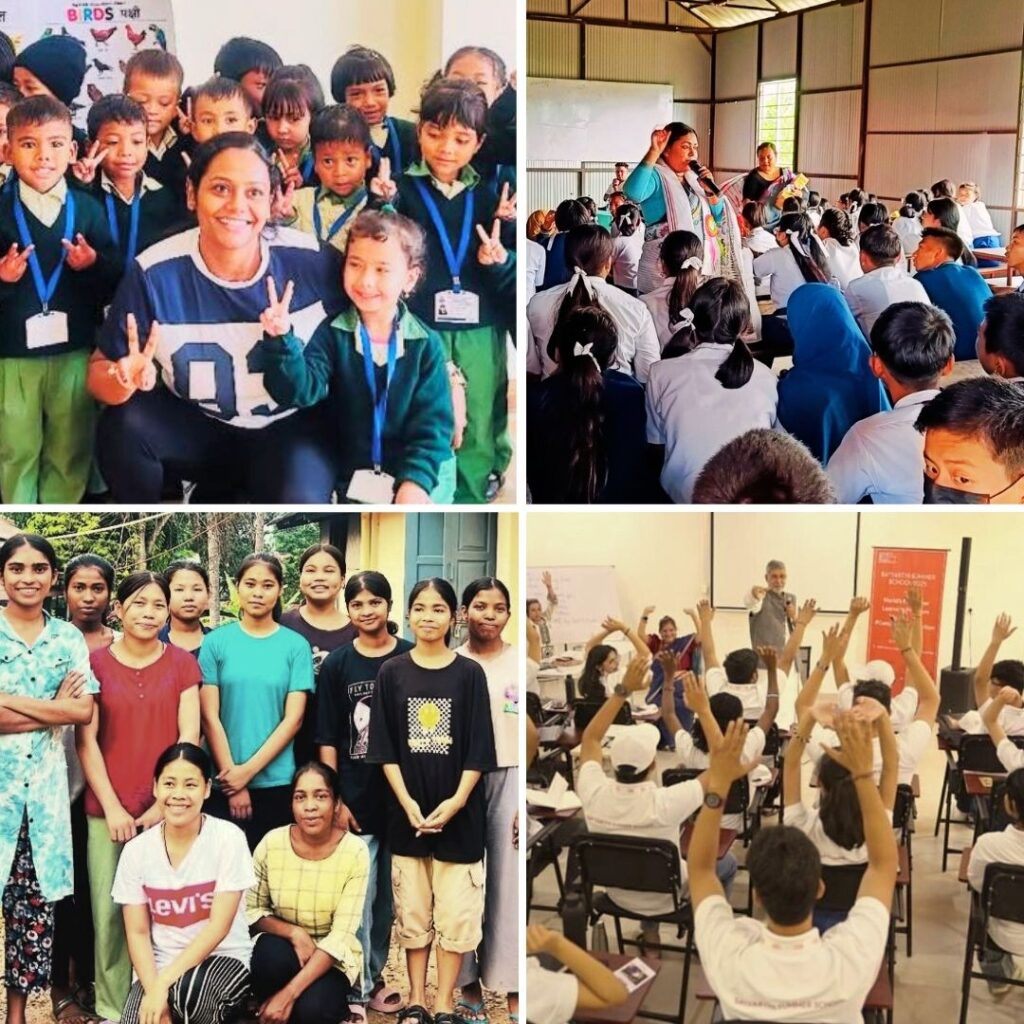“A sound like Aye, B sounds like Ba, C sounds like Ka…”
Sarala Pawara, a young confident girl with a rather loud voice, is busy teaching English to some 30 odd kids in a large airy room with peeling walls. The kids sit on a mat on the floor and repeat after her. Sarala teaches from a big colourful banner with the alphabets and their corresponding sounds in Marathi hung near the blackboard on the wall in front of the students. Occasionally a kid or two loses attention but Sarala is quick to bring the kid back into the classroom.
Sarala with her students.
Sarala is a part of an interesting and ambitious experiment initiated by her villagers almost a year back. It is an experiment fueled by a dream that all the villagers have pledged their support to. The dream is to make Joyada, their village, the first English literate village in India.
Sarala with the teacher team which teaches English using Leap For Word methodology.
Joyada is a village near the Maharashtra-Madhya Pradesh border with a population of around 3000 people, of whom nearly one third are of school going age. All the villagers belong to a tribe called Pawara with a language their own (called Pawari) which sounds a little like Gujarati to the untrained ear. The Pawaras are spread over the border districts of Gujarat, Madhya Pradesh and Maharashtra and most of them are engaged in farming and livestock rearing. Most young Pawaras speak and understand Marathi quite well.
The experiment started nearly a year back when Shamlal Pawara and four of his friends stood for the Gram Panchayat elections and won. Shamlal is a quiet, unassuming man of few words but deep ambitions. He could’ve been the Sarpanch but chose to be a Samiti member so that he could focus on his area of interest, education. A farmer by profession he’s been teaching English to kids in his village in his spare time for the last few years under a program run by a non-profit called Leap For Word.
Shyamlal(Left) and Deva with students.
“I was unemployed and used to do small household stuff and did a bit of farming earlier. Then I met the coordinator of LeapForWord – a non-profit that trains teachers in English language delivery – in Shirpur, Rohidas Pawara, and he asked me to join in running English classes in the village. I hesitated because I was never good at English in the first place. But two days later he again emphasized on doing it and said that you would get the required training and then I said yes”. He smiles and says that “Everything changed after that, as if someone used a magic wand.”
Based out of Mumbai, Leap For Word has been working in Shirpur for the last ten years and has programs running in Pune, Thane and Raigad districts in Maharashtra as well as in Gujarat and Karnataka. Their flagship solution – The English Literacy Program – is aimed at enabling the rural school teacher to effectively teach English. This solution is built on top of a Translation Algorithm developed as a result of more than 10 years of grassroots work in some of the most infrastructure scarce locations. Teachers not fluent in English are trained to teach the subject to their kids in the local language. In villages like Joyada, where it’s almost impossible to find anyone with even a basic comprehension of the language, this solution makes immense sense. Leap For Word is on a mission to take this program across the country and train one million teachers in the next five years.
“As it is, the quality of education in our schools is very low. The less spoken about English the better”, says Sarala. She should know for she has experienced the situation on ground, first hand.
Joyada has five Zilla Parishad schools all of which teach till the 4th standard only. Once the kids grow older, most of them move to schools in nearby villages some four-five kilometres away.
One of the Joyoda schools
A lot of kids are sent to the Ashram schools (residential schools built for tribal kids, where education, food and shelter is taken care of by the government till the 10th standard) where most of them finish their high school. Very few youngsters, however, move beyond this. Those who are good enough and aspire to complete their graduation, do so in the town nearby. The most common courses pursued by these students are BA, ITI or Diploma in Education.
“Even if our kids are smart, they end up struggling in their board exams because they fail or barely pass their English papers”, says Shamlal. “They end up doing either BA or B.Ed, neither of which leads to jobs. Knowledge of English is important if they want to get ahead and do anything in their careers.”
Shamlal, himself a D.Ed, was clear about how he wanted to use his position in the Panchayat and set to work immediately after winning the elections. He along with the Sarpanch identified four educated local youth and asked them to run classes in the village. He then called a meeting of th…












